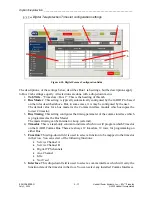
Digital Teleprotection __________________________________________________________________
RF-MCGARDPRO
Hubbell Power Systems, Inc.
–
RFL™
Products
July 1, 2022
©2022 Hubbell Incorporated
6-20
•
“Disabled”: This value is shown if the Teleprotection channel is not
mapped to an interface and the channel’s “Enable” setting is set to
“Auto”
•
“Forced Disabled”: This value is shown if the channel’s “Enable” setting
is set to “Disable”
{
over Interface on Bus, timeslot
}: This value is only shown if the channel is
mapped to an interface and Timeslot on a Bus. This value does not
depend on the Enable status, it is independent. If a channel is mapped to
Timeslot 3 of Comms Bus 1, over the C37.94 interface in Slot 2, then
this value will read “over Slot 2 C37.94 on Bus 1, TS3”.
Bus 1, TS3: This is a link to the Timeslot status page for the bus (1 or 2).
In this example, clicking Bus 1, TS3 would take the user to “Status >
Digital Comms > Slot 2 – C37.94 (Timeslots > Bus 1)” page (tab).
4.
Label
: This is populated by the “Label” setting created for the associated channel in the
“Configuration > Digital Teleprotection” page.
5.
Ping-Pong
: This is the calculated one-way channel delay. This value is equal to the
round-trip delay measurement, divided by 2. When the value in this field exceeds the
“Ping Pong Alarm” setting from the “Configuration > Digital Teleprotection” page, an
alarm condition is created.
6.
Frame OK:
This status indicates the status of the received teleprotection message. If
the message is not received correctly this will indicate an alarm.
7.
Tx Address
: This is populated by the “Tx Address” setting for the associated channel in
the “Configuration > Digital Teleprotection” page.
8.
Rx Address
: This status indicates the expected receive address as programmed. If the
received address does not match the expected address this will indicate an alarm.
9.
Reset All
: This button resets the counters of the associated Teleprotection channel.
“Errors per Second” and “Errored Seconds” will be reset. This will not affect the Bit
Error Rate counter.
Note
: The user must confirm the reset, “Are you sure you want to reset the Ch1
counters?”
10.
Bit Error Rate
: This status indicates the average bit error rate. When the value exceeds
the set bit error rate threshold and alarm is created.
11.
Errors per Second
: This status indicates the average errors per second. One error is
equivalent to one 32-bit message containing CRC errors. The maximum errors per
second is 2,000.
Note
: This field can be reset to zero by the “Reset All” counters button on this page.
12.
Errored Seconds
: This status indicates the cumulative number of seconds where
messages with CRC errors have been received. This value will roll-over to zero after the
maximum value of 65,535.
















































